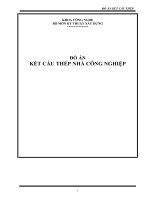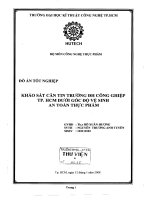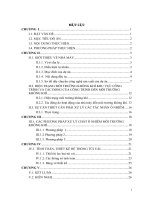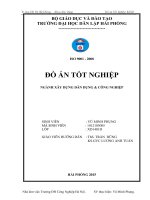An overview of strategies for promoting student engagement in online English courses - Trường Đại học Công nghiệp Thực phẩm Tp. Hồ Chí Minh
Bạn đang xem bản rút gọn của tài liệu. Xem và tải ngay bản đầy đủ của tài liệu tại đây (420.24 KB, 7 trang )
<span class='text_page_counter'>(1)</span><div class='page_container' data-page=1>
<b>AN OVERVIEW OF STRATEGIES FOR PROMOTING </b>
<b>STU-DENT ENGAGEMENT IN ONLINE ENGLISH COURSES </b>
<i><b>Pham Dieu Ly, Nguyen Thi Thao</b><b>*</b></i>
Date received the article: 3/4/2020
Date received the review results: 5/10/2020
Date published the article: 27/10/2020
<i><b>Abstract: </b>The authors in this study learnt about online education and student </i>
<i>engage-ment in order to fi nd out fi ve eff ective strategies for promoting student engagement in our </i>
<i>online English courses. Online education is defi ned as any educational undertaking that </i>
<i>pri-marily utilizes the internet to deliver coursework, assessments and assignments from teacher </i>
<i>to student. (Ashley, 2019). Whereas, student engagement contains three components: </i>
<i>behav-ioral engagement, emotional engagement and cognitive engagement (Fredricks et al, 2004). </i>
<i>These three components are interrelated within individuals, so infl uenced by three </i>
<i>psycho-logical needs: autonomy, relatedness and competence (Hew (2014). In online courses, the </i>
<i>following fi ve factors could engage students: (1) problem</i>-<i>oriented learning with clear and </i>
<i>comprehensive instructions, (2) instructor accessibility, (3) peer interaction, (4) active </i>
<i>learn-ing, and (5) course resources to address participant learning needs since they are infl uential </i>
<i>to individual’s selfness. The authors suggested the strategies based on these factors to </i>
<i>im-prove student engagement in online English courses. </i>
<i><b>Keywords: </b>online education, student engagement, strategies, promoting, English courses, </i>
<i>components, psychological needs</i>
* Faculty of Tourism - Hanoi Open University
<b>1. Introduction</b>
The rise of the internet and the easy
access that most students have to
com-puters, smartphones, and Wi-Fi networks
have powerfully infl uenced education.
Consequently, online education has been
considered a key aspect of curriculum in
many schools. However, for many
peo-ple, the expression “online education”
is suspicious; both teachers and students
are reluctant to get involved in any
</div>
<span class='text_page_counter'>(2)</span><div class='page_container' data-page=2>
‘no other choice’ motivated the authors
to seek for eff ective strategies to promote
student engagement. Working through the
past studies, we came across the reliable
theoretical background about online
ed-ucation and student engagement which
helped us give out the solution to our
problems. Although there has been any
thorough research on the eff ectiveness of
such strategies, positive feedback from
our students could be a reliable proof.
<b>2. Online education</b>
In the last 20 years, the Internet has
grown from being nearly non-existent into
the largest, most accessible database of
in-formation ever created. It has changed the
way people communicate, shop, socialise,
do business and think about knowledge
and learning. Much more than just a new
twist on distance learning, online
school-ing is changschool-ing the face of traditional
classrooms and making education more
accessible than ever before.
What is online education? Online
education is a form of education where
students use their home computers through
the internet. Often online graduation and
course programmes, some of which are
conducted using digital technologies, are
provided via the online learning portal of
the host university.
Computer-based training,
Web-based training, Internet Web-based training,
online training, e-learning (electronic
learning), m-learning (mobile learning),
computer-aided distance education -
on-line education goes by many names and
comes in a variety of styles. Today, the
term “online education” can be
under-stood as any educational undertaking
that primarily utilizes the internet to
deliver coursework, assessments and
as-signments from teacher to student
(Ash-ley, 2019).
From this simple definition comes
an almost infinite number of ways to teach
and learn outside of traditional classrooms
and away from college campuses. It can
include audio, video, text, animations,
vir-tual training environments and live chats
with teachers. It is a rich learning
envi-ronment with much more flexibility than
a traditional classroom.
When used to its full potential,
on-line education has been shown to be eff
ec-tive in comparison with pure face-to-face
instruction. It can be engaging, fun and
tailored to fit students’ needs.
<b>3. Student engagement </b>
Student engagement is considered
by many educators to be an important
as-pect of a teaching and learning context
because it can infl uence students’
reten-tion, learning, achievement test scores
and graduation (Appleton, Christenson
& Furlong, 2008; Fredricks,
Blumen-feld & Paris, 2004). Being an abstract
construct, student engagement has been
defi ned in various ways. Despite the
dif-ferent defi nitions, scholars have largely
identifi ed student engagement as a
con-struct that contains three components:
behavioral engagement, emotional
en-gagement and cognitive enen-gagement
(Fredricks et al, 2004).
</div>
<span class='text_page_counter'>(3)</span><div class='page_container' data-page=3>
aff ective responses or feeling towards
teachers, peers, the course and learning,
whereas <i>cognitive engagement refers to </i>
the task-specifi c thinking that a student
employs while undertaking in an activity
(Helme & Clarke, 1998). It is important to
note that in reality these three components
are dynamically interrelated within the
in-dividual; they are not isolated processes
(Fredricks et al, 2004).
<b>4. Individuals’ psychological needs</b>
Hew (2014) presented a possible
model of how the three psychological
needs might infl uence the three aspects of
engagement.
<i>Figure 1. How psychological needs infl uence aspects of engagement Hew (2014) </i>
<i>Autonomy refers to the need for </i>
freedom or perceived choice over one’s
action. The need for autonomy provides a
motivational basis for students’
behavior-al engagement because an individubehavior-al can
choose to participate or not to participate
in an activity (Skinner, Furrer, Marchand
& Kindermann, 2008). Individuals need
to feel that they are acting from their own
volition and voluntarily participating in
an activity, instead of being forced into
doing something. However, the notion of
autonomy does not imply that guidance
from an authority is not needed at all.
For some individuals, having autonomy
over their own learning may prove to be
a bane as they may not know how to
pro-ceed in learning a subject matter. It may
be the case that learner autonomy is best
achieved when, among other things, the
teacher acts as a counsellor or a resource
(Thanasoulas, 2000). Autonomy also
pro-vides a motivational basis for emotional
engagement because it is reasonable to
as-sume that the sense of psychological
free-dom over course activities would likely to
engender positive student feelings towards
the course itself (Skinner et al, 2008).
</div>
<span class='text_page_counter'>(4)</span><div class='page_container' data-page=4>
between students and students or between
students and the instructor could lead to
more positive feelings (ie, stronger
emo-tional engagement) towards the course
and learning. The level of interactions can
be infl uenced by the degree of
familiari-ty students have with one another or with
the instructor (Cheung, Hew & Ng, 2008).
Students tend to interact more with
oth-er people they are familiar with. This
de-gree of familiarity may be compromised
in courses with large student numbers
because it is harder to get to know other
people more intimately in the class.
Con-sequently, this could lead to fewer student
interactions and eventually weaker
emo-tional engagement towards the course.
<i>Competence refers to the need for a </i>
person to master one’s pursuits or
learn-ing (Helme & Clarke, 1998); hence it may
be considered to be a critical motivation
factor for students’ cognitive engagement.
Competence also provides a motivational
basis for behavioral and aff ective
engage-ment because it is reasonable to assume
that a sense of mastery about the topic
be-ing studied would encourage a learner to
further participate in the course activities,
as well as foster positive learner feelings
about the course.
<b>5. Infl uential factors on student </b>
<b>engagement in online courses</b>
Previous research that examined
on-line courses has suggested several factors
that could infl uence student engagement.
These factors include course
resourc-es (Sull, 2012) instructor accresourc-essibility
and passion (Das, 2012), peer interaction
(Sull, 2012), active learning (Harrington
& Floyd, 2012) and problem-oriented
with clear expositions (Kelly, 2012).
</div>
<span class='text_page_counter'>(5)</span><div class='page_container' data-page=5>
The course resources also play a
ma-jor role in fostering student engagement in
online courses. The instructors employed
a wide variety of resources and activities
such as video lectures, online discussion
forums and/or chats, quizzes, weekly
tasks, course readings and links to other
valuable materials to help engage students
and maximize their learning. According to
Bangert (2004), using an array of relevant
resources and activities is one approach to
address the diverse range of learning
pref-erences and skills that participants may
bring to the learning environment.
<i>Instructor accessibility may be </i>
de-fi ned as the extent an instructor is willing
to interact with course participants. The
lack of instructor accessibility is probably
one of the greatest criticisms of large-scale
education (Warren, Rixner, Greiner &
Wong, 2014). A high degree of instructor
accessibility is likely to increase the
likeli-hood of student engagement. On the other
hand, a low degree of instructor
accessibil-ity could cause students to feel that no one
is addressing their questions. Moreover,
one of the most frequently mentioned
traits of instructors who can motivate their
students are passionate ones. Specifi cally,
these instructors exhibited a genuine love
for subject matters and interest in teaching
the students.
<i>Peer interactions could </i>
encour-age knowledge sharing and construction
among participants. Probably the most
common social component of online
courses is the discussion forums
(War-ren et al, 2014).
Engagement is promoted when
<i>ac-tive learning is emphasized and </i>
support-ed. Bonwell and Eison (1991) defi ne
ac-tive learning as any task or activity that
involves students in doing things and
thinking about the things they are doing.
<i>Problem-oriented with clear </i>
<i>exposi-tions is another important factor. The defi</i>
-nition of problem diff ers among various
scholars. Following Merrill (2002), we
use the term problem to refer to a range
of activities, with the most critical
charac-teristic being that the activity is
represen-tative of what a learner might encounter
in the world. A problem-oriented
instruc-tion is therefore concerned about teaching
learners the necessary concepts or skills
in order to understand or solve some real
-world tasks.
<b>6. Strategies for promoting </b>
<b>stu-dent engagement in online English </b>
<b>courses</b>
Based on the theoretical background
about online education, student
engage-ment, individuals’ psychological needs,
infl uential factors on student engagement
in online courses and their relation, the
authors worked together to detail what
should be done in our on English courses.
The following specifi c strategies are well
presented: (1) course resources to address
participant learning needs, (2) instructor
accessibility, (3) peer interaction, (4)
ac-tive learning, and (5) problem-oriented
learning with clear and comprehensive
in-structions. The specifi c strategies that can
be used for each factor are described as
follows:
<i><b>(1)</b></i> <i><b>Course resources to address </b></i>
<i><b>participant learning needs</b></i>
</div>
<span class='text_page_counter'>(6)</span><div class='page_container' data-page=6>
In addition, online video lectures
could be slowed down or speeded up to
suit students’ listening preference while
availability of slides was essential for
vid-eo lectures to allow students to review the
materials.
We tried our best to give out a rich
resource of relevant course information,
including suggestions for further readings,
optional videos or self-study worksheets.
<i><b>(2) Instructor accessibility and </b></i>
<i><b>passion</b></i>
We provided a dedicated class
ser-vice that allowed our students to contact
us for support as soon as possible. In
or-der to avoid being overloaded, we asked
the leader of each class to select frequent
questions and spent a specifi c amount of
time in each online session directly
ad-dressing students’ questions. It was about
15 minutes or up to 30 minutes.
Beside that we saved the contact of
technical support staff and shared it with
our students. As a result, we could avoid
any bad impact on the delivery due to
technical problems which may seriously
aff ect students’ engagement.
Furthermore, being aware of the
importance of the teacher’s passion, we
worked at a high level of enthusiasm.
Luckily, we both shared our great passion
for tourism and earned a lot of travel
expe-riences, so we not only delivered the
les-sons but also raised the students’ love for
the industry. As a result, many students
were engaged by the excitement that we
had about the subject as well as our
enthu-siasm in teaching it.
<i><b>(3) Peer interaction</b></i>
We employed panel-style
discus-sions that were spontaneous and not
re-hearsed in google meet rooms, helping
our students feel like they were in the
class participating in the dialogue.
We provided our students the
op-portunity in dedicated sub-forums to
fol-low-up or seek clarifi cation from peers
re-garding the review comments received. At
this step, the application of ‘padlet’ was
of great help. For example, in one lesson
of PET 4, all students posted their ideas
of qualities of good hoteliers on a padlet
(using the link shared by the teacher).
Af-ter that, we gave them a specifi c period
of time (5-10 minutes) to respond to their
classmates’ ideas. Surprisingly, they were
quite excited; which was concluded based
on the feedback selected at the end of the
lesson.
<i><b>(4) Active learning</b></i>
</div>
<span class='text_page_counter'>(7)</span><div class='page_container' data-page=7>
Another strategy is that we could
play a video which was followed by
ques-tions for students’ refl ections; in many
les-sons, a good video both sustained student
attention and contributed to the
achieve-ment of learning objectives.
We also used LMS quizzes that
test-ed the relevant concepts taught in a
partic-ular week to provide immediate feedback
to students on their performance. Quizzes
contained a mixture of questions that
as-sessed the following types of cognitive
pro-cesses: understanding, analyzing, applying
and evaluating. What is worth noting is the
purpose of these quizzes, which was to help
students review the course content via one
or more of the following strategies: (1) the
quizzes reviewed or reinforced the main
points covered in the lectures, (2) the
quiz-zes gave clear answer explanations, and (3)
the quizzes allowed multiple retakes of the
questions.
<i><b>(5) Problem</b><b>‐</b><b>oriented with clear </b></i>
<i><b>ex-position</b></i>
Throughout our lessons, we
con-centrated on something functional in the
real world. It was incredibly eff ective for
tourism-related English lessons. When we
taught the students in PET4, we made a
sit-uation in which a customer with a special
interest is looking for a good tourism
prod-uct. Our students had to design a Nich
tour-ism product to satisfy the customer. Our
students were really involved, then during
the task, they also reinforced their
acquisi-tion of Nich tourism.
However, teachers have to take note
of the fact that the situation should be
conducted step by step. Therefore, step
-by-step instruction, providing examples,
is requested for students’ better
compre-hension and task completion.
<b>7. Conclusion</b>
This article shared the strategies
we applied into our English course in the
second semester of the school year
2019-2020 to promote student engagement in
fully online courses. The provision of
course resources would give students a
clear idea of what they are actually
sup-posed to do in the course. The
availabil-ity of extra course resources also allows
students who are interested in a topic to
explore it further. These cater to a
stu-dent’s need for autonomy. Furthermore,
the use of various online resources and
activities also helped students achieve a
sense of mastery of the topics covered.
This caters to a student’s need for
com-petence. In addition, instructor
accessibil-ity and peer interactions would foster the
sense of relatedness which in turn aff ects
students’ aff ective engagement. Instructor
and peer interactions could increase
stu-dents’ positive feelings towards a course
and help them stay engaged. Furthermore,
an instructor’s enthusiasm in teaching the
course, as well as his/her willingness to
interact with students (eg, answer student
questions) also plays an important role in
meeting students’ need for competency.
The use of active learning strategies and
problem-oriented learning with clear
ex-positions that focus on making
meaning-ful connections to the real world helps
foster a students’ sense of competence in
mastering the subject being studied.
</div>
<!--links-->









